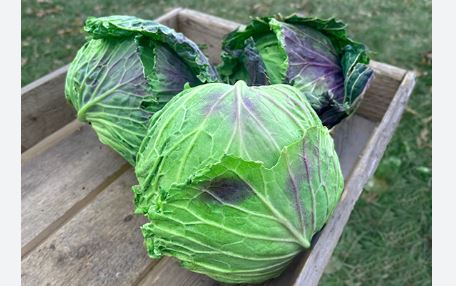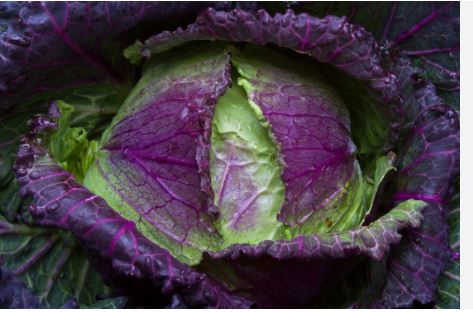
Botanical Classification
January King Cabbage, scientifically classified as Brassica oleracea var. capitata, belongs to the Brassicaceae family, which includes other cruciferous vegetables like broccoli, kale, and cauliflower. This cultivar is a type of savoy cabbage, distinguished by its crinkled, vibrant leaves.
The Brassica oleracea species encompasses a wide range of cultivated varieties, all derived from wild cabbage native to coastal Europe. January King is a hybrid, likely developed from crossing savoy and white cabbage varieties, resulting in its unique appearance and hardiness.
Origin and History
January King Cabbage originated in Europe, with its roots traced to 19th-century England and France. It was bred for its ability to withstand cold winters, earning its name from its harvest period in late winter, particularly January. This heirloom variety became popular among farmers for its resilience in frost-prone regions, making it a staple in European gardens.
Its development reflects centuries of selective breeding by farmers to enhance traits like cold tolerance and flavor, cementing its place in traditional European cuisine.
Identifying Characteristics

January King Cabbage is easily recognizable by its semi-savoyed, crinkled leaves that form a tight, round head. The outer leaves display a striking mix of green with purple or reddish hues, especially in colder conditions, which trigger anthocyanin production.
The heads are typically medium to large, weighing 2–5 pounds, with a dense, compact core. Its leaves are thicker and more robust than those of standard green cabbage, yet softer and less waxy than other savoy types, offering a distinctive texture.
Taste
The flavor of January King Cabbage is mildly sweet with a subtle earthiness, less pungent than other cabbages. Its tender, crinkled leaves provide a slightly crisp texture when raw, becoming softer and sweeter when cooked.
The cold weather enhances its sweetness, as frost encourages the plant to convert starches into sugars. This balanced flavor profile makes it versatile for both raw and cooked preparations, appealing to those who prefer a less intense cabbage taste.
Seasons/Availability
January King Cabbage thrives in cooler climates and is typically planted in late summer for a winter harvest, with peak availability from late fall through early spring (November to March in the Northern Hemisphere). Its frost tolerance allows it to remain in the ground during mild winters, and cold exposure enhances its flavor. In regions with harsh winters, it may be harvested earlier or grown in protected environments. It is commonly found in farmers’ markets and specialty grocers during these months.
Culinary Uses
January King Cabbage is highly versatile in the kitchen, suitable for both raw and cooked dishes. Its crisp, colorful leaves make it ideal for fresh salads, coleslaws, or as a vibrant garnish. When cooked, it excels in braises, stir-fries, soups, and stews, where its tender texture and sweet flavor shine.
It pairs well with rich ingredients like bacon, butter, or cream, as well as tangy flavors like vinegar or citrus. In European cuisines, it’s often used in traditional dishes like stuffed cabbage rolls or fermented as sauerkraut.
Nutritional Value
January King Cabbage is a nutritional powerhouse, low in calories yet rich in essential nutrients. It provides significant amounts of vitamin C, an antioxidant that supports immune health, and vitamin K, crucial for blood clotting and bone health. It also contains dietary fiber, aiding digestion, and small amounts of folate, manganese, and vitamin B6.
Like other cruciferous vegetables, it is high in glucosinolates, compounds linked to potential cancer-fighting properties. Its vibrant purple-tinged leaves indicate the presence of anthocyanins, which offer additional antioxidant benefits.
Cultivation of January King Cabbage
- Climate Requirements: January King Cabbage thrives in cool climates, with ideal temperatures between 45°F and 65°F. It is highly frost-tolerant, enduring temperatures as low as 20°F (-6°C), which enhances its sweetness by converting starches to sugars. Excessive heat can lead to loose heads or bolting, making it best suited for late fall to early winter harvests in most regions.
- Soil Preferences: This cabbage prefers fertile, well-drained loamy soil with a pH of 6.0–7.5. Incorporate generous amounts of organic matter, such as compost or well-rotted manure, to improve soil fertility and structure. Good drainage is essential to prevent root rot, and a neutral pH ensures optimal nutrient uptake.
- Planting Time: In the U.S., sow January King Cabbage seeds in late summer (July–August) for a winter harvest (November–March). Seeds can be started indoors 6–8 weeks before transplanting or sown directly when soil temperatures are around 50°F–70°F. Transplants should be set out when seedlings are 4–6 inches tall.
- Seed Selection: Opt for high-quality, disease-resistant January King seeds from reputable suppliers. As an heirloom variety, it offers consistent flavor and cold hardiness. Ensure seeds are fresh, as viability decreases with age, and avoid hybrids if preserving traditional traits is desired.
- Spacing and Planting: Space plants 18–24 inches apart in rows 24–36 inches apart to allow for large, dense heads to form. Proper spacing promotes air circulation, reducing disease risk, and ensures adequate sunlight for the vibrant green and purple leaves to develop.
- Watering Needs: Maintain consistent soil moisture, providing 1–1.5 inches of water per week, adjusted for rainfall. Avoid waterlogging, as it can cause root issues, and ensure even watering to prevent head splitting. Drip irrigation is recommended for efficient moisture delivery.
- Fertilization: January King Cabbage is a moderate feeder, requiring a balanced fertilizer (e.g., 10-10-10) at planting. Side-dress with a nitrogen-rich fertilizer when heads begin forming, typically 4–6 weeks after transplanting. Avoid over-fertilizing late in the season to prevent excessive leaf growth at the expense of head development.
- Pest Management: Common pests include cabbage worms, aphids, and slugs. Use row covers to protect young plants, hand-pick pests, or apply organic controls like neem oil or diatomaceous earth. Encourage natural predators like ladybugs to manage aphid populations effectively.
- Disease Control: Fungal diseases like clubroot and blackleg can affect January King Cabbage, particularly in poorly drained soils. Practice crop rotation every 3–4 years, maintain proper soil pH, and remove plant debris to minimize disease risk. Choose resistant seeds when available.
- Weed Control: Keep the growing area weed-free to reduce competition for nutrients and light. Apply organic mulch, such as straw or wood chips, to suppress weeds, retain soil moisture, and regulate temperature, which supports healthy root systems.
- Support and Pruning: January King Cabbage forms compact heads and typically does not require staking. Remove damaged or yellowing outer leaves to improve air circulation and reduce pest habitats. Minimal pruning is needed, but trimming lower leaves can enhance head appearance.
- Harvesting: Harvest when heads are firm and reach 2–5 pounds, typically 90–120 days after transplanting. Cut the head at the base with a sharp knife, leaving outer leaves intact for potential regrowth in mild climates. Frost exposure enhances flavor, so harvesting after a light frost is ideal.
- Post-Harvest Care: Store January King Cabbage in a cool, humid environment (32°F–40°F) for up to 2–3 months. Wrap heads in plastic or store in perforated bags to maintain freshness. For extended harvests, stagger plantings every 2–3 weeks during the planting season.